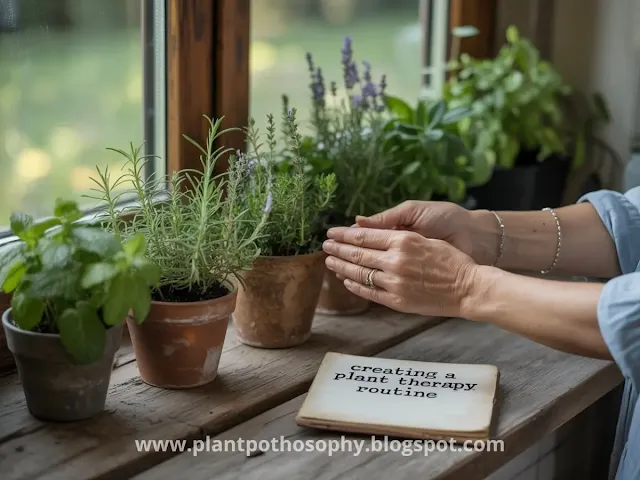Creating a Plant Therapy Routine: A Guide to Healing with Nature
 |
| A Guide to Healing with Nature |
Begin by Setting Your Intention for Healing
Before you bring any plant into your life, ask yourself why you're drawn to plant therapy. Are you looking to reduce anxiety, find a sense of purpose, or simply create a peaceful space? By clarifying your intention, you give your routine a deeper meaning and stay motivated over time.For example, if you're seeking calm after a hectic day, your routine might include quiet evening watering sessions. If you're working through grief or burnout, the process of nurturing new growth can be symbolic and healing. Keep your intention close — even write it down near your favorite plant as a reminder of your "why."
Choose Plants That Support Your Emotional Goals
Plants have personalities — some calm, some energize, others purify. Choose varieties that match your emotional and environmental needs.- Lavender: Known for its relaxing scent; perfect for reducing anxiety.
- Peace Lily: Elegant and symbolic of harmony and peace.
- Snake Plant: Low-maintenance and excellent for air purification.
- Aloe Vera: Soothing both in energy and application, with medicinal uses.
- English Ivy: Symbol of resilience and growth.
Create a Sacred Green Space
Your plant therapy routine will be most effective in a space where you feel relaxed and grounded. Designate a corner of your home as your "healing garden," even if it’s just a windowsill.Surround your plants with elements that soothe your senses: soft lighting, natural textures, calming music, or even aromatherapy. Add a small cushion or stool where you can sit and observe your plants. Over time, this becomes your sanctuary — a place where you can pause, breathe, and reconnect with yourself.
Build a Daily Ritual of Connection
Consistency is key in building any healing practice. Your plant therapy routine should include a daily or near-daily ritual that fosters mindfulness and connection.Start simple:
- Morning Check-In: Greet your plants with a gentle touch. Check soil moisture, observe leaves, and note any changes.
- Watering Meditation: Use watering time as a mindful practice — slow, deliberate, and present.
- Gratitude Moment: While misting or pruning, say something you're grateful for aloud or silently.
Journal Your Plant Journey
Journaling helps track both plant growth and emotional transformation. Keep a notebook nearby to jot down what you observe and feel during your routine.- Did a new leaf unfurl?
- Did the light in the room change the plant’s energy?
- Did caring for your plant shift your mood?
Incorporate Movement and Breathwork
Enhance your plant therapy routine with gentle movement or breathing exercises. While standing near your plants, take deep, slow breaths and stretch your body. Let your plants remind you of natural rhythms — reaching toward light, taking in air, responding to the seasons.This grounding combination of physical awareness and plant presence can ease anxiety, release tension, and bring your attention back to the present.
Celebrate Progress — Yours and Theirs
Healing is not linear, and neither is plant growth. Some days your Monstera may sprout a new leaf; other days, it might droop or lose one. Let these cycles reflect your own ups and downs.Celebrate small victories:
- A plant bouncing back after adjusting its care.
- A deeper sense of calm after your daily check-in.
- A renewed connection to yourself after tending to others.
Share the Healing with Others
As your plant therapy practice deepens, consider sharing it. Invite friends into your green space. Gift a cutting to a loved one. Join a local plant swap or therapy group.Sharing plants and the peace they bring can multiply the healing effect. You'll be surprised how often others are drawn to your plant haven — and how it might inspire their own journey toward healing.
Evolve With the Seasons
Just as nature shifts, your routine should, too. Adjust your practice with the seasons:- Spring: Focus on new beginnings — repotting, starting seeds, planning.
- Summer: Celebrate abundance — bloom watching, sharing cuttings.
- Autumn: Reflect and slow down — prune gently, prepare for rest.
- Winter: Embrace stillness — dim lights, soft care, quiet moments.
